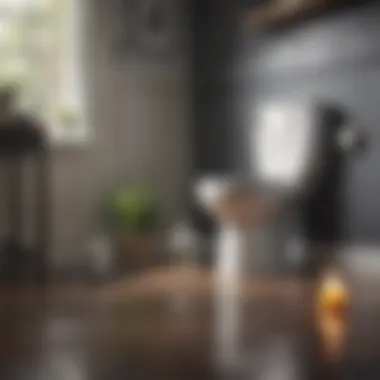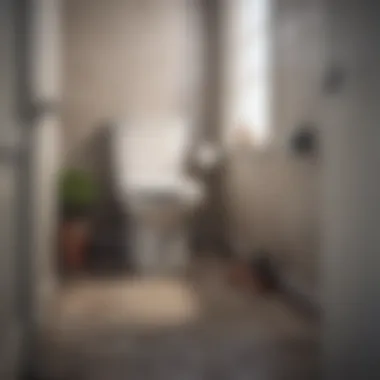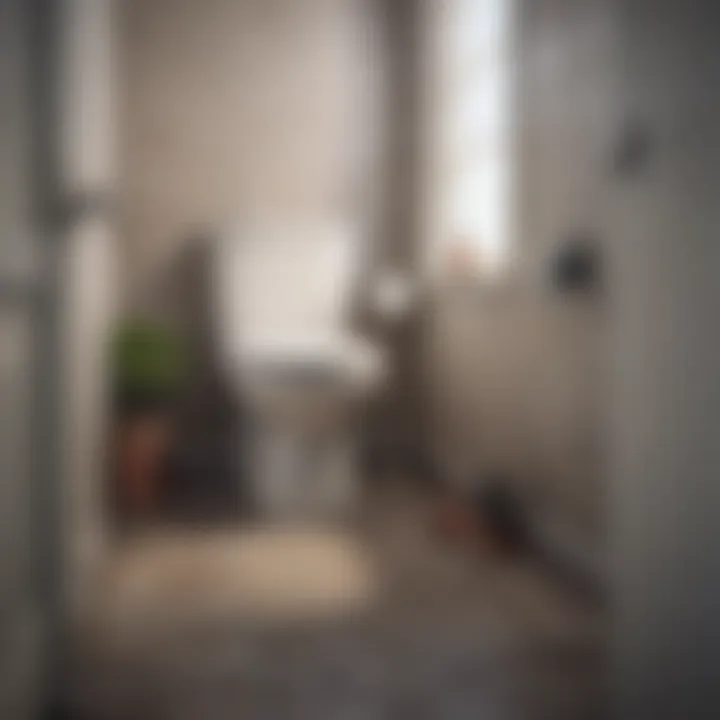Mastering Toilet Clogs: No Plunger Needed


Intro
Dealing with a clogged toilet is an scenario everyone faces eventually. The frustrating moment of realizing you have no plunger on hand can escalate quickly, making the situation seem dire. This article is designed to guide you through this challenge, providing practical methods to unclog a toilet without the typical tools. We will cover various techniques, tools that are readily available in your home, and preventative measures to minimize future clogs. By understanding the rationale behind these methods, you will feel equipped to maintain cleanliness and efficiency in your bathroom.
Techniques for Unclogging
Several effective methods exist to address toilet clogs without a plunger. Let's explore some of the alternatives:
Hot Water Method
One of the simplest approaches involves using hot water. Here's how:
- Boil Water: Bring a large pot of water to a boil. Avoid using water that is too hot, as it can crack porcelain.
- Pour Slowly: Once boiled, slowly pour the hot water from waist height into the toilet bowl. This helps to break down the clog.
- Wait: Allow a few minutes for the water to work its way through the blockage.
- Flush: Try flushing the toilet after waiting to see if the water drains properly.
Dish Soap Technique
Using dish soap can also be effective in loosening stubborn clogs. To apply:
- Apply Soap: Pour a generous amount of dish soap into the toilet bowl.
- Warm Water: Follow it with warm water, not boiling.
- Wait: Let it sit for 10-15 minutes to coat the blockages.
- Flush: Afterward, flush the toilet as usual.
Wire Hanger Method
If the clog is particularly stubborn, a wire coat hanger can be used. To safely implement this method:
- Straighten the Hanger: Unravel a wire hanger, leaving a hook at one end.
- Insert: Carefully insert the hook into the toilet bowl, aiming to snag any blockage.
- Push Gently: Avoid using too much force, as this could damage the toilet.
- Clear and Flush: If you feel resistance, gently push and pull to dislodge the clog before flushing.
Tools and Alternatives to Use
Although you may not have a plunger, several household items can help with unclogging:
- Sponge: A heavy-duty sponge can absorb water and may help push through minor clogs.
- Bucket: Using a bucket can help apply additional water pressure to aid in the unclogging process.
- Vinegar and Baking Soda: A mix of these can create pressure that helps lift the blockage. Pour half a cup of baking soda and follow it with one cup of vinegar, allowing to sit before flushing.
Preventative Measures
To reduce the chances of future clogs, consider these practices:
- Be Mindful of Waste: Limit flushing non-degradable items, like wipes or feminine products.
- Regular Maintenance: Schedule routine checks and cleaning.
- Monitor Toilet Usage: If you have younger children, consider educating them on proper usage to prevent clogs.
Maintaining an efficient toilet system not only saves stress but also ensures a cleaner home environment.
Closure
Navigating toilet clogs without a plunger is a practical skill. By utilizing hot water, dish soap, or even household tools like a wire hanger, you can effectively manage clogs. Understanding preventative measures can also help maintain toilet functionality over time. With this knowledge, you are now better equipped to tackle common toilet issues head-on.
Understanding Toilet Clogs


Understanding toilet clogs is essential for maintaining a functional and hygienic bathroom. Clogs can disrupt daily routines and lead to costly plumbing repairs if not addressed quickly. Being equipped with knowledge about what causes these blockages can aid in prevention, saving both time and money. Furthermore, understanding the specific elements of toilet clogs enables one to address issues swiftly, thereby enhancing the efficiency of household management.
Common Causes of Toilet Clogs
Toilet clogs stem from various factors. Recognizing these causes aids in taking preventative measures. Common causes include:
- Excessive toilet paper: Flushing large amounts of toilet paper at once can lead to blockages, as it may not fully disintegrate.
- Foreign objects: Items like toys, wipes, or dental floss can easily obstruct the toilet's internal mechanisms.
- Sanitary products: Feminine hygiene products are designed to absorb moisture and swell, making them problematic when flushed.
- Low-flow toilets: These toilets may not use enough water to effectively clear waste out of the bowl.
Awareness of these culprits can guide users in what to avoid, thus decreasing the likelihood of clogs.
Signs of a Toilet Clog
Recognizing the early signs of a clog is crucial. Addressing these signs promptly may prevent further complications. Common indicators include:
- Slow draining: If water drains away slowly, it is a signal that a clog is forming.
- Gurgling noises: Sounds coming from the toilet or nearby drains may indicate a blockage.
- Overflowing toilet: If the water level rises unusually high, it is a sure sign of a clog.
Being attentive to these signs not only helps in immediate response but also contributes to a long-term understanding of one’s plumbing system.
When a Plunger is Not Available
In situations where a plunger is not readily accessible, knowing alternative methods to unclog a toilet becomes essential. The inability to plunge a toilet can lead to frustration and inconvenience, emphasizing the need for practical solutions. This section provides various strategies to tackle these issues without a plunger. It highlights tools and techniques that can yield results, enabling you to maintain functionality in your bathroom.
Assessing the Situation
Before attempting to unclog a toilet, take a moment to assess the extent of the clog. Understanding whether the blockage is severe or minor will inform your approach. Look for signs such as slow draining or water levels rising. If the water in the bowl is stable and not excessively high, the clog might be manageable with simple methods. Recognizing the situation at hand prevents unnecessary mess and saves time, allowing you to choose the most effective method.
Gathering Alternative Tools
Various tools can serve as substitutes when a plunger is not available. Here are some notable options:
Dish soap
Dish soap can effectively lubricate the clog. It is designed to break down grease and grime, making it an apt candidate for tackling toilet blockages. By adding a generous amount to the toilet, the soap works to ease the passage through the pipe. Its thick consistency allows it to cling to the blockage, helping to dislodge it. Though it is generally safe, avoid excessive amounts that could create unnecessary suds in the toilet.
Hot water
Hot water can be a powerful tool against a clog. The heat helps to dissolve the matter causing the blockage. Pouring hot water directly into the toilet bowl from waist height can enhance its effectiveness. This method allows the water to create enough force to break up the jam. Always ensure the water is hot but not boiling, as boiling water may crack the porcelain. This method is simple and cost-effective, making it highly favorable in unclogging situations.
Baking soda and vinegar
The combination of baking soda and vinegar is well-known for its effectiveness in cleaning and unclogging. When poured into the toilet, the baking soda reacts with the vinegar, creating a fizzing action that can help to loosen the obstruction. This chemical reaction is both safe and environmentally friendly. However, it may take some time for the reaction to work, so patience is key. This method is also popular due to its low cost and availability in most households.
A wire hanger
A wire hanger can serve as a makeshift tool for reaching deeper clogs. By bending it into a straight line with a small hook at the end, you can navigate through the toilet's curve and try to dislodge the blockage manually. This method requires care, as excessive force may damage the toilet's interior. It is beneficial for certain types of clogs that are visible and reachable. However, caution is necessary to avoid scratches or breakage.
A vacuum cleaner


Using a vacuum cleaner, specifically a wet/dry model, can effectively pull out solid clogs from the toilet. Ensure the vacuum is suited for liquid pickup and seal the hose to create a strong suction. This method is effective for certain blockages but requires proper handling to avoid messes. The vacuum can help remove stubborn materials like toys or wipes that are difficult to clear otherwise. However, this approach may not be feasible for all homeowners due to equipment availability.
By gathering these alternative tools, you can prepare yourself to address toilet clogs efficiently and effectively, even without a plunger at hand.
Step-by-Step Methods to Unclog a Toilet
Unclogging a toilet can feel daunting, especially when a plunger is not handy. However, employing effective methods can simplify the process and relieve the stress associated with clogged toilets. This section provides various techniques, each with its unique benefits and considerations. Mastering these methods allows one to tackle most clogging issues without the need for specialized tools. The right approach can save time, prevent mishaps, and maintain the functionality of your bathroom.
Using Dish Soap
Dish soap is a surprisingly effective solution for unclogging toilets. It serves as a lubricant, helping to break down debris in the bowl. The process is simple: pour a generous amount of dish soap directly into the toilet bowl. Let it sit for about 15 minutes. This allows the soap to penetrate the blockage. After waiting, follow up with a bucket of hot water. The combination of dish soap and hot water can help flush away the clog.
Applying Hot Water
Hot water can be quite effective in dissolving certain types of clogs. It is essential to use water that is hot but not boiling. Boiling water might crack the porcelain of the toilet. To apply this method, fill a bucket with hot water. From waist height, carefully pour the hot water into the toilet bowl. The force of the water can help dislodge the blockage. Wait a few minutes and then flush the toilet to see if the clog is cleared.
Employing Baking Soda and Vinegar
The combination of baking soda and vinegar creates a chemical reaction that can help clear toilet clogs. Start by pouring a cup of baking soda directly into the toilet followed by a cup of vinegar. The bubbling action produced can help to break down the obstruction. Allow this mixture to sit for at least 30 minutes. After the waiting period, flush the toilet. This method is particularly effective for organic material and can be a safer alternative to harsh chemicals.
Utilizing a Wire Hanger
A wire hanger can be fashioned into a tool to help dislodge stubborn blockages. To prepare, straighten the hanger but leave a small hook at one end. Carefully insert the hooked end into the toilet drain. Gently maneuver it to hook or push the clog free. This method may require patience and a delicate touch to avoid damaging the toilet. It is also advisable to wear gloves for hygiene purposes.
Using a Vacuum Cleaner
A wet-dry vacuum is another option for dealing with toilet clogs. This method is effective but comes with specific considerations. First, ensure the vacuum is designed for wet and dry use. Bring the vacuum to the bathroom, fit it over the toilet bowl, and create a seal. Activate the vacuum to pull out the clog. Ensure you are cautious not to damage the toilet during the process. This method is typically suited for more severe clogs that do not respond to other techniques.
Preventative Measures Against Future Clogs
Preventative measures are essential in maintaining a functional toilet and preventing inconvenient clogs. Taking proactive steps helps avoid many issues and ensures that the toilet operates smoothly. Ignoring these measures can lead to significant problems, not only in personal inconvenience but also in potential plumbing expenses.
Understanding Proper Usage of Toilets
Using the toilet correctly is vital to prevent clogs. Many people do not realize that certain items should not be flushed down the toilet. This includes:
- Feminine hygiene products, which can expand and cause blockages.
- Wipes marketed as flushable; they don't disintegrate like toilet paper.
- Large items, such as paper towels, that do not break down easily.
Education about what can or cannot be flushed is essential. It prevents simple mistakes that can lead to serious plumbing issues. A well-informed household is the first line of defense against toilet clogs.
Regular Maintenance Tips
Regular maintenance is another critical aspect of preventing clogs. Implementing routine practices can save time and trouble in the long run.
Flushing Practices


Flushing practices significantly contribute to the overall maintenance of a toilet. It is best to flush only two or three pieces of toilet paper at a time to avoid overwhelming the system. This reduces the chance for blockage to form.
By training oneself to avoid excessive flushing and monitoring what goes down, one can maintain a healthy plumbing system. Gentle flushing also becomes a beneficial habit, minimizing stress on the plumbing infrastructure.
Scheduled Cleaning
Scheduled cleaning plays a key role in maintaining a clean and functional toilet. Setting a regular schedule, such as weekly or bi-weekly, helps ensure cleanliness. This practice includes scrubbing the bowl and cleaning around the base to prevent buildup.
By preventing grime and organic matter from accumulating, scheduled cleaning proves to be an effective choice for toilet maintenance. Regularly cleaning also means one can easily spot potential problems before they escalate.
When to Call a Professional
Knowing when to enlist professional help for toilet issues is vital in maintaining a functional plumbing system. The steps you take during a clog can determine whether the situation escalates or can be effectively handled at home. Calling a plumber is sometimes not just a matter of convenience; it can be crucial to prevent further damage to your toilet and plumbing.
Several elements can inform your decision about seeking expert assistance. Problems that seem minor can turn into significant issues if misjudged. It is often more economical to seek help early than attempt a DIY solution that leads to costly repairs or extensive plumbing services later.
Indicators of Severe Clogs
Several clear signs indicate that a clog is more severe than a mere inconvenience. First, observe if the flushing action is irregular. When a toilet takes longer to flush or the water level rises alarmingly, it can signify a stubborn blockage deeper in the plumbing.
Another indicator is the presence of backflow in other fixtures. If your bathroom sink or shower experiences drainage issues simultaneously, this can indicate systemic problems requiring a professional's assistance.
- Frequent clogs - If the toilet clogs repeatedly even after your best unclogging attempts, it is time to call a plumber.
- Slow drains - If all fixtures in the bathroom drain slowly, there may be a main sewer line blockage.
- Unpleasant odors - Foul smells often signal trapped waste or an issue in plumbing that needs to be investigated.
- Water pooling - Standing water around the base of the toilet could point to a leak that needs immediate attention.
Understanding Plumbing Issues
Comprehending broader plumbing systems can help homeowners recognize when more than a clogged toilet is at stake. In many homes, a single toilet can be connected to a more extensive drainage system.
If the clog is a symptom of a more significant plumbing issue, focusing only on the toilet may overlook critical root causes.
Some situations require insights into the plumbing layout:
- Pipe condition: Older pipes may rust or weaken, leading to breaks and more extensive repair needs.
- Tree roots: Roots from trees can infiltrate sewer lines, causing blockages that no household method can resolve.
- Slope issues: Improperly installed pipes can cause traps where debris accumulates.
In instances like these, reaching out to plumbing professionals ensures you receive the appropriate expertise and tools for the diagnosis and repair. Ensuring your plumbing works effectively adds comfort and value to your home.
The End
In this article, we explored several effective techniques to unclog a toilet when a plunger is not on hand. Understanding the methods available empowers a person in a potentially frustrating situation. Recognizing the symptoms of a clog is crucial as it lays the groundwork for effectively addressing the issue. Furthermore, employing household items such as dish soap, hot water, or baking soda and vinegar can serve as immediate solutions.
Recap of Effective Methods
To summarize, the methods we discussed include:
- Using Dish Soap: This can help lubricate the clogged materials, making them easier to remove.
- Applying Hot Water: Pouring hot water (not boiling) can soften the clog.
- Using Baking Soda and Vinegar: This natural reaction can break down debris effectively.
- Employing a Wire Hanger: A straightened wire hanger can help dislodge stubborn blockages.
- Utilizing a Vacuum Cleaner: A wet/dry vacuum can extract clogs without creating a mess.
Each method has its pros and cons, but they share one common goal: restoring proper toilet function efficiently.
The Importance of Regular Maintenance
Regular toilet maintenance plays a key role in preventing clogs in the first place. Understanding how to use a toilet properly is fundamental. Avoid flushing non-biodegradable items, such as wipes or feminine hygiene products. Regular cleaning with appropriate solutions also ensures any buildup is dealt with before it becomes a significant issue.
By fostering good habits and employing these methods, homeowners can minimize disruptions caused by toilet clogs. Remember, while DIY solutions can be effective, know when it’s necessary to call in a professional to avoid larger plumbing issues.







